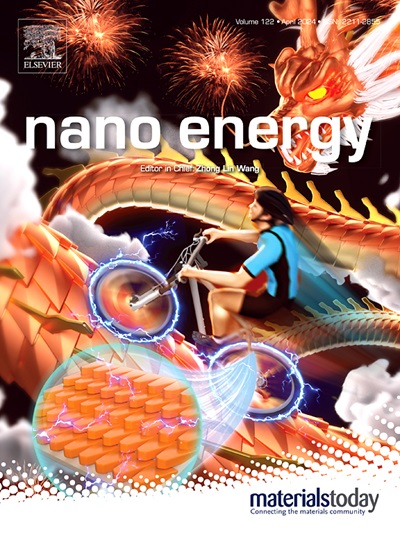通过1,8-二碘辛烷/苯乙基碘化铵2D钙钛矿钝化策略,为太阳能和室内照明应用赋予钙钛矿模块
IF 17.1
1区 材料科学
Q1 CHEMISTRY, PHYSICAL
引用次数: 0
摘要
为了加速钙钛矿技术的商业化及其在多个应用领域的应用,人们开发了几种器件加工策略。这些努力主要针对大规模生产的设备制造和提高不同光源(太阳或室内光)的性能。这项工作提出了一种新的3D/2D钙钛矿异质结构,通过在3D钙钛矿吸收器上直接沉积一层苯乙基碘化铵(PEAI)和1,8-二碘辛烷(DIO)的混合层,而无需进一步退火步骤。DIO的加入使得在室温下形成纯净的2D PEA₂PbI₄4 (n = 1),导致3D钙钛矿表面缺陷钝化,提高了2D钙钛矿的结晶度,优化了钙钛矿/空穴输运界面的偶极矩。经过PEAI:DIO处理的大面积PSC模块在1次太阳照射下的功率转换效率分别为17.7% (32 cm²)和15.6% (121 cm²)。当暴露在各种LED强度(200,500和1000勒克斯)的室内照明下时,PEAI:DIO工程模块的效率接近34%,是迄今为止使用钙钛矿的大面积模块中效率最高的,带隙低于1.7 eV。遵循iso - d -1协议的长期稳定性测试显示,与未经处理的设备相比,T80寿命增加了三倍。本文章由计算机程序翻译,如有差异,请以英文原文为准。

Empowering perovskite modules for solar and indoor lighting applications by 1,8-diiodooctane/phenethylammonium iodide 2D perovskite passivation strategy
To accelerate commercialization of perovskite technology and its use in multiple application fields, several device processing strategies have been developed. These efforts primarily target scaling-up device fabrication for mass production and enhancing performance for different light sources (sun or indoor light). This work presents a novel 3D/2D perovskite heterostructure by depositing a mixed layer of phenethylammonium iodide (PEAI) and 1,8-diiodooctane (DIO) directly atop the 3D perovskite absorber without a further annealing step. The addition of DIO enables the formation of pure 2D PEA₂PbI₄ 4 (n = 1) at room temperature, leading to defect passivation of 3D perovskite surface, improvement in the crystallinity of 2D perovskite, and optimizing the dipole moment at perovskite/hole transport interface. Large-area PSC modules treated with PEAI:DIO achieve remarkable power conversion efficiencies of 17.7 % (32 cm²) and 15.6 % (121 cm²) under 1Sun irradiation. When exposed to indoor illumination with various LED intensities (200, 500 and 1000 lux) the PEAI:DIO engineered module demonstrated efficiency approaching 34 %, among the highest reported so far for large area modules employing perovskite with bandgap below 1.7 eV. Long-term stability tests following the ISOS-D-1 protocol reveal a threefold increase in T80 lifetime compared to untreated devices.
求助全文
通过发布文献求助,成功后即可免费获取论文全文。
去求助
来源期刊

Nano Energy
CHEMISTRY, PHYSICAL-NANOSCIENCE & NANOTECHNOLOGY
CiteScore
30.30
自引率
7.40%
发文量
1207
审稿时长
23 days
期刊介绍:
Nano Energy is a multidisciplinary, rapid-publication forum of original peer-reviewed contributions on the science and engineering of nanomaterials and nanodevices used in all forms of energy harvesting, conversion, storage, utilization and policy. Through its mixture of articles, reviews, communications, research news, and information on key developments, Nano Energy provides a comprehensive coverage of this exciting and dynamic field which joins nanoscience and nanotechnology with energy science. The journal is relevant to all those who are interested in nanomaterials solutions to the energy problem.
Nano Energy publishes original experimental and theoretical research on all aspects of energy-related research which utilizes nanomaterials and nanotechnology. Manuscripts of four types are considered: review articles which inform readers of the latest research and advances in energy science; rapid communications which feature exciting research breakthroughs in the field; full-length articles which report comprehensive research developments; and news and opinions which comment on topical issues or express views on the developments in related fields.
 求助内容:
求助内容: 应助结果提醒方式:
应助结果提醒方式:


